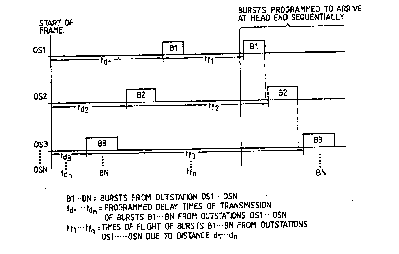Some of the information on this Web page has been provided by external sources. The Government of Canada is not responsible for the accuracy, reliability or currency of the information supplied by external sources. Users wishing to rely upon this information should consult directly with the source of the information. Content provided by external sources is not subject to official languages, privacy and accessibility requirements.
Any discrepancies in the text and image of the Claims and Abstract are due to differing posting times. Text of the Claims and Abstract are posted:
| (12) Patent Application: | (11) CA 2090108 |
|---|---|
| (54) English Title: | TDMA RANGING |
| (54) French Title: | TELEMETRIE AMRT |
| Status: | Deemed Abandoned and Beyond the Period of Reinstatement - Pending Response to Notice of Disregarded Communication |
| (51) International Patent Classification (IPC): |
|
|---|---|
| (72) Inventors : |
|
| (73) Owners : |
|
| (71) Applicants : |
|
| (74) Agent: | SMART & BIGGAR LP |
| (74) Associate agent: | |
| (45) Issued: | |
| (86) PCT Filing Date: | 1991-12-11 |
| (87) Open to Public Inspection: | 1992-06-13 |
| Examination requested: | 1993-02-22 |
| Availability of licence: | N/A |
| Dedicated to the Public: | N/A |
| (25) Language of filing: | English |
| Patent Cooperation Treaty (PCT): | Yes |
|---|---|
| (86) PCT Filing Number: | PCT/GB1991/002198 |
| (87) International Publication Number: | WO 1992010884 |
| (85) National Entry: | 1993-02-22 |
| (30) Application Priority Data: | ||||||
|---|---|---|---|---|---|---|
|
2090108 9210884 PCTABS00014
In Multistation Demand Assigned Time Division Multiple Access
Systems digital information is communicated from a head end to a
population of oustations so that all the outstations receive the
same stream of digital information and select their traffic from it.
Traffic is only sent to and from an outstation when there is a
demand for it. As the outstations are at random ranges from the
head end it is necessary to know the time of travel for a burst of
information so they arrive at the head end sequentially. The
traffic dependent free time is consolidated and made available for
ranging-in outstations.
Note: Claims are shown in the official language in which they were submitted.
Note: Descriptions are shown in the official language in which they were submitted.

2024-08-01:As part of the Next Generation Patents (NGP) transition, the Canadian Patents Database (CPD) now contains a more detailed Event History, which replicates the Event Log of our new back-office solution.
Please note that "Inactive:" events refers to events no longer in use in our new back-office solution.
For a clearer understanding of the status of the application/patent presented on this page, the site Disclaimer , as well as the definitions for Patent , Event History , Maintenance Fee and Payment History should be consulted.
| Description | Date |
|---|---|
| Inactive: IPC from MCD | 2006-03-11 |
| Inactive: IPC from MCD | 2006-03-11 |
| Inactive: Dead - No reply to s.30(2) Rules requisition | 1998-10-08 |
| Application Not Reinstated by Deadline | 1998-10-08 |
| Deemed Abandoned - Failure to Respond to Maintenance Fee Notice | 1997-12-11 |
| Inactive: Abandoned - No reply to s.30(2) Rules requisition | 1997-10-08 |
| Inactive: S.30(2) Rules - Examiner requisition | 1997-04-08 |
| Request for Examination Requirements Determined Compliant | 1993-02-22 |
| All Requirements for Examination Determined Compliant | 1993-02-22 |
| Application Published (Open to Public Inspection) | 1992-06-13 |
| Abandonment Date | Reason | Reinstatement Date |
|---|---|---|
| 1997-12-11 |
Note: Records showing the ownership history in alphabetical order.
| Current Owners on Record |
|---|
| GPT LIMITED |
| Past Owners on Record |
|---|
| DAVID LESLIE HEDDERLY |